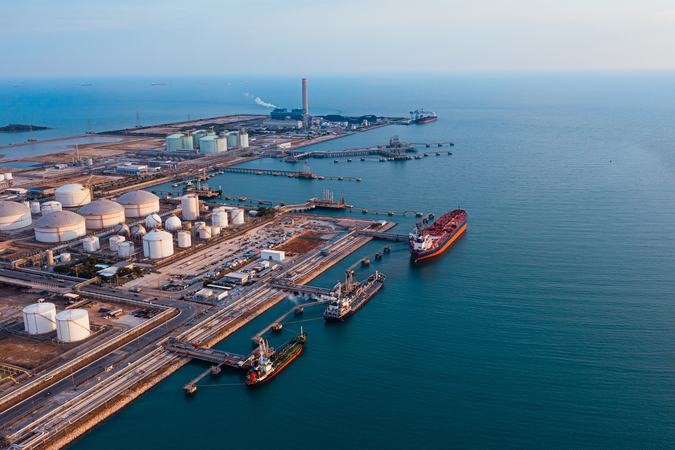How Much Are Rising Oil and Gas Exports Increasing US Energy Prices and Methane Emissions?
💡 What’s the story?
Around 2015, the United States opened up the taps to exporting large quantities of crude oil and natural gas overseas, driving demand for US-produced oil and gas. The particularly rapid ascent of exported liquefied natural gas has recently raised concerns about the potential for exports to drive up US energy prices and carbon emissions. According to new modeling by Resources for the Future (RFF) fellow Brian C. Prest, the anticipated surge in liquefied natural gas exports may drive relatively low carbon-intensive oil and gas production, while rising oil exports drive high carbon-intensive production.
The modeling showed that rising liquefied natural gas export demand drives higher gas prices, which in turn disproportionately increases natural gas supply from Appalachia, where gas infrastructure leaks less methane into the atmosphere than average. The story is reversed for rising oil export demand, which disproportionately drives production in the Permian Basin, where methane leaks are substantially more common. The result: while natural gas exports have received the bulk of the attention in recent years from climate-conscious observers and policymakers, Prest found that oil exports have likely been a bigger driver of methane pollution.
📊 How do we know?
The paper’s findings are a result of RFF’s Dynamic Oil and Gas Market Analysis (DOGMA) Model, which projects how US oil and gas drilling and production respond to price fluctuations at the county level. Using DOGMA, Prest mapped the impacts of increased US oil and gas export demand on US oil and gas prices, where additional oil and gas comes from, and the methane intensity of that added supply.
Oil and natural gas production are closely linked—for example, when demand for crude oil increases and companies drill for more oil as a result, natural gas is oftentimes produced as a byproduct; and when natural gas is produced, oil is often produced alongside it as well.
Expert Perspective
“Understanding the dynamics between natural gas and oil, their prices, and their related emissions is important to truly understanding how the energy economy intersects with emissions-reduction efforts. Perhaps counterintuitively, the modeling shows that US crude oil exports may have had more influence on methane emissions than natural gas exports.”
—Brian C. Prest, RFF Fellow
💵 How do prices and demand interact?
The modeling shows that an increase in 1 billion cubic feet per day of natural gas export demand increases US natural gas prices by approximately 2.5 percent. This export demand also leads to a 0.5 percent reduction in crude oil prices since more liquefied natural gas leads to additional supply of coproduced oil.
When demand for natural gas rises, Appalachia produces much of the additional natural gas. The modeling shows that Appalachia is much more sensitive to changes in natural gas prices than the Permian Basin; however, because Appalachia produces little oil, its oil production responds little to oil price changes.
Production in the Permian Basin is much more sensitive to oil prices than to gas prices. When oil demand rises, gas with high leak rates from the Permian Basin crowds out Appalachian gas produced with low leak rates, because the Permian coproduces so much natural gas alongside the oil.
➡️What’s next?
Prest notes that the future of US methane leakage rates is uncertain since new technologies, processes, or policies can reduce the amount of methane that is released into the atmosphere. International supply and demand may also be in flux as the energy mix continues to transition to renewable energy sources.
Big picture, Prest’s modeling projects that Appalachia will continue to produce a significant amount of gas, and the Permian Basin a significant amount of oil, in 2050. In fact, the modeling projects that US oil and gas production will likely continue to rise through 2050.
📚 Where can I learn more?
Read the working paper, “Where Does the Marginal Methane Molecule Come From? Implications of LNG Exports for US Natural Gas Supply and Methane Emissions,” by RFF Fellow Brian C. Prest.
Prest also joined Resources Radio to talk about the paper—you can listen to the new episode here.
Resources for the Future (RFF) is an independent, nonprofit research institution in Washington, DC. Its mission is to improve environmental, energy, and natural resource decisions through impartial economic research and policy engagement. RFF is committed to being the most widely trusted source of research insights and policy solutions leading to a healthy environment and a thriving economy.
Unless otherwise stated, the views expressed here are those of the individual authors and may differ from those of other RFF experts, its officers, or its directors. RFF does not take positions on specific legislative proposals.
For more information, please see our media resources page or contact Media Relations and Communications Manager Annie Tastet.




